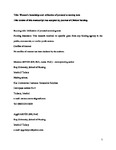Women's knowledge and utilization of prenatal screening tests: A Turkish study
| dc.contributor.author | Seven, M | |
| dc.contributor.author | Akyüz, A | |
| dc.contributor.author | Eroglu, K | |
| dc.contributor.author | Daack-Hirsch, S | |
| dc.contributor.author | Skirton, H | |
| dc.date.accessioned | 2016-10-27T12:08:01Z | |
| dc.date.accessioned | 2016-12-08T10:57:51Z | |
| dc.date.available | 2016-10-27T12:08:01Z | |
| dc.date.issued | 2016-08-03 | |
| dc.identifier.issn | 0962-1067 | |
| dc.identifier.issn | 1365-2702 | |
| dc.identifier.uri | http://hdl.handle.net/10026.1/8084 | |
| dc.description.abstract |
<jats:sec><jats:title>Aims and objectives</jats:title><jats:p>The aim of the study was to determine the rate of use of prenatal screening tests and the factors affecting the decision to have a prenatal screening test in pregnant women in Turkey.</jats:p></jats:sec><jats:sec><jats:title>Background</jats:title><jats:p>Prenatal genetic screening as an optional service is commonly used to determine a level of risk for genetic conditions in the foetus.</jats:p></jats:sec><jats:sec><jats:title>Design</jats:title><jats:p>A quantitative cross‐sectional survey.</jats:p></jats:sec><jats:sec><jats:title>Methods</jats:title><jats:p>Pregnant women (<jats:italic>n</jats:italic> = 274) who sought prenatal care from one hospital in Turkey were recruited and asked to complete questionnaires that were developed by the researchers. Descriptive and inferential statistics were used to analyse the data.</jats:p></jats:sec><jats:sec><jats:title>Results</jats:title><jats:p>Almost half (44·2) % of the women were primiparas, and the majority (97·8%) were in the third trimester of pregnancy. Only 36·1% of the women reported that they had prenatal screening by either the double test or triple test. Women had a low level of knowledge regarding prenatal screening: the mean knowledge score was 3·43 ± 3·21 of a possible score of 10. Having consanguineous marriage, a history of spontaneous abortion, a child with genetic disorder, multiparity or a longer marriage duration were positively correlated with accepting a prenatal screening test.</jats:p></jats:sec><jats:sec><jats:title>Conclusions</jats:title><jats:p>This study has provided baseline data on the uptake and reasons for accepting or declining a prenatal screening in a cohort of Turkish women. There is evidence to suggest that more education is needed to improve knowledge and provide comprehensive nursing care to promote informed consent in this context.</jats:p></jats:sec><jats:sec><jats:title>Relevance to clinical practice</jats:title><jats:p>Perinatal nurses are ideally situated to inform pregnant women about prenatal screening tests to improve access to healthcare services and to ensure informed decisions are made by pregnant women and their partners.</jats:p></jats:sec> | |
| dc.format.extent | 1869-1877 | |
| dc.format.medium | Print-Electronic | |
| dc.language | en | |
| dc.language.iso | en | |
| dc.publisher | Wiley | |
| dc.relation.replaces | http://hdl.handle.net/10026.1/6653 | |
| dc.relation.replaces | 10026.1/6653 | |
| dc.subject | prenatal care | |
| dc.subject | screening test | |
| dc.subject | pregnancy | |
| dc.subject | use | |
| dc.title | Women's knowledge and utilization of prenatal screening tests: A Turkish study | |
| dc.type | journal-article | |
| dc.type | Article | |
| plymouth.author-url | https://www.ncbi.nlm.nih.gov/pubmed/27487389 | |
| plymouth.issue | 13-14 | |
| plymouth.volume | 26 | |
| plymouth.publication-status | Published | |
| plymouth.journal | Journal of Clinical Nursing | |
| dc.identifier.doi | 10.1111/jocn.13494 | |
| plymouth.organisational-group | /Plymouth | |
| plymouth.organisational-group | /Plymouth/Faculty of Health | |
| dc.publisher.place | England | |
| dcterms.dateAccepted | 2016-07-16 | |
| dc.rights.embargodate | 2017-8-3 | |
| dc.identifier.eissn | 1365-2702 | |
| dc.rights.embargoperiod | Not known | |
| rioxxterms.versionofrecord | 10.1111/jocn.13494 | |
| rioxxterms.licenseref.uri | http://www.rioxx.net/licenses/all-rights-reserved | |
| rioxxterms.licenseref.startdate | 2016-08-03 | |
| rioxxterms.type | Journal Article/Review |


